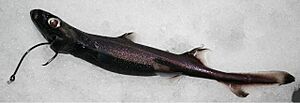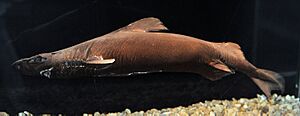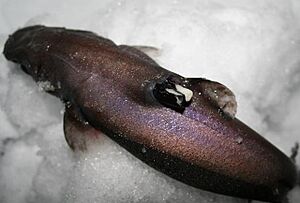Velvet belly lanternshark facts for kids
Quick facts for kids Velvet belly lanternshark |
|
|---|---|
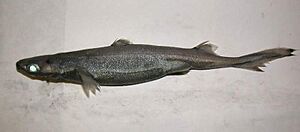 |
|
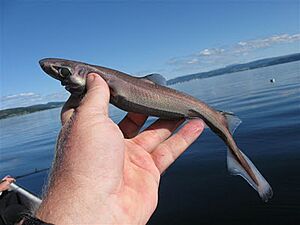 |
|
| Conservation status | |
| Scientific classification | |
| Genus: |
Etmopterus
|
| Species: |
spinax
|
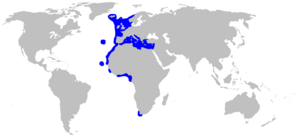 |
|
| Range of the velvet belly lantern shark | |
| Synonyms | |
* ambiguous synonym |
|
The velvet belly lanternshark (or just velvet belly) is a type of dogfish shark known scientifically as Etmopterus spinax. It's one of the most common deep-sea sharks found in the northeastern Atlantic Ocean. You can find it from Iceland and Norway all the way down to Gabon and South Africa. These sharks live deep underwater, usually between 20 and 2,490 meters (about 65 to 8,170 feet) below the surface.
This small shark usually grows to about 45 centimeters (18 inches) long. It gets its name "velvet belly" because its black underside looks very different from the brown color on the rest of its body. Like other lanternsharks, the velvet belly can glow in the dark! It has special light-emitting organs called photophores on its sides and belly. These lights help the shark blend in with the dim light from above, hiding it from both predators and prey. The glowing patterns might also help these sharks talk to each other.
Young velvet bellies eat tiny krill and small fish. As they get older and bigger, their diet changes to include squid and shrimp. These sharks are born live, with litters of six to 20 young every two to three years. Even though they are often caught by accident in deep-sea fishing nets, they don't have much commercial value. Because of fishing pressure and their slow breeding rate, scientists are a bit worried about their numbers.
Contents
About the Velvet Belly Lanternshark
The velvet belly lanternshark was first described in 1758 by a famous Swedish scientist named Carl Linnaeus. He is often called the "father of taxonomy" because he created the system we use to name and classify living things. He named it Squalus spinax. The word spinax refers to the shark's spiny dorsal fins. Later, it was moved to the Etmopterus group.
The common name "velvet belly" comes from its unique look. The shark's underside is a deep black, which stands out sharply from the brown color on its back, just like a patch of soft velvet.
Where They Live
The velvet belly lanternshark lives in the eastern part of the Atlantic Ocean. Its home stretches from cold waters near Iceland and Norway down to warmer areas off Gabon. It also lives in the Mediterranean Sea, around the Azores, the Canary Islands, and Cape Verde. Some have even been seen off South Africa.
These sharks prefer to live on the outer edges of the continental and island shelves, and on the upper slopes of the ocean floor. They like areas with mud or clay. While they can be found from 20 meters (65 feet) deep to an amazing 2,490 meters (8,170 feet) deep, they are most common between 200 and 500 meters (650 to 1,640 feet).
What They Look Like
The velvet belly is a strong shark with a fairly long, wide, and flat snout. Its mouth has thin, smooth lips. The teeth on its upper jaw are small, while the teeth on its lower jaw are much bigger and shaped like blades. It has five tiny pairs of gill slits, which are openings that allow it to breathe underwater.
Both of its dorsal fins (the fins on its back) have strong, grooved spines at the front. The second dorsal fin is much larger than the first. The shark does not have an anal fin (a fin on its underside near the tail). Its tail is slender and leads to a long caudal fin (tail fin).
The shark's skin is covered in tiny, hooked scales called dermal denticles, which are spread out and not in a regular pattern. Its body is brown on top and suddenly turns black underneath. It also has thin black marks above and behind its pelvic fins and along its tail fin.
The velvet belly has many photophores, which are special organs that glow with a blue-green light. This light can be seen from 3 to 4 meters (10 to 13 feet) away! These glowing organs are arranged in nine patches on the shark's sides and belly, creating a unique pattern for this species. The largest velvet belly ever found was 60 centimeters (24 inches) long, but most are around 45 centimeters (18 inches). Female sharks are usually larger than males.
Life in the Deep Sea
The velvet belly lanternshark is one of the most common deep-sea sharks in the northeastern Atlantic. They can be found alone or in small groups. In some areas, there are more females than males, especially among older sharks. Also, larger adult sharks tend to live in deeper waters than younger ones. This might help reduce competition for food between different age groups.
The velvet belly has some cool adaptations for living in the deep sea. Its liver is very large, making up about 17% of its body weight. Three-quarters of its liver is oil, which helps the shark float easily in the water. To deal with the higher amounts of heavy metals found in the deep ocean, this shark has special cells in its blood that can find and remove harmful substances. It also has special proteins in its liver that can detoxify metals like cadmium, copper, and mercury.
The shark's glowing ability helps it hide. By matching the dim light coming from the surface, the shark's silhouette disappears, making it hard for predators looking up to see it. The unique glowing patterns might also help these sharks find mates or communicate with each other in the dark. Larger fish, including other sharks, sometimes eat velvet bellies. A major predator is the longnosed skate.
Velvet bellies often have many parasites, both inside and outside their bodies. Some parasites are tiny worms or tapeworms that the shark gets from eating its prey. Others, like the barnacle Anelasma squalicola, attach to the shark's back near its fin spine. These barnacles can dig deep into the shark's muscle and can even affect the shark's ability to have babies.
What They Eat
Velvet bellies are generalist predators, meaning they eat a variety of things. Their diet includes crustaceans (like shrimp and krill), cephalopods (like squid and cuttlefish), and bony fishes (like lanternfishes). Smaller velvet bellies, under 27 centimeters (11 inches) long, mainly eat krill and a small fish called Maurolicus muelleri. As they grow bigger, their diet becomes more varied, including more squid and shrimp. Scientists think smaller velvet bellies might be too slow to catch fast-moving squid.
Life Cycle and Reproduction
The velvet belly lanternshark is ovoviviparous. This means the eggs hatch inside the mother's uterus, and the embryos grow by getting nutrients from a yolk sac. The mother gives birth to live young. Their reproductive cycle might take two to three years. They have litters of six to 20 young, and larger females tend to have more babies. When they are born, the young sharks are about 12 to 14 centimeters (5 to 5.5 inches) long.
Interestingly, the shark's ability to glow develops before it's even born! The yolk sac glows before the light-emitting organs form, which suggests the mother passes glowing materials to her babies. The first glowing tissue appears when the embryo is very small, and the full glowing pattern is ready by the time it's 95 millimeters (3.7 inches) long. At birth, the young shark can already use its lights to hide from predators.
Velvet bellies grow slowly, but faster than some other deep-sea sharks. Males become ready to reproduce when they are about 28 to 33 centimeters (11 to 13 inches) long, and females at 34 to 36 centimeters (13 to 14 inches) long. Males usually mature around 4 years old, and females around 4.7 years old. Scientists estimate that males can live up to 18 years, and females up to 22 years.
Velvet Bellies and Humans
Many velvet bellies are caught by accident in fishing nets, especially in deep-sea trawls used for catching shrimp and lobster, or on longlines used for other fish. These sharks usually don't have much commercial value, so they are almost always thrown back into the ocean, often not surviving. Sometimes, they are dried and salted or made into fishmeal.
The IUCN has listed the velvet belly as "Near Threatened." This means that while its population is stable in many areas, its numbers have dropped in some places, like by almost 20% between 1970 and 2004. The slow rate at which these sharks reproduce makes it hard for their populations to recover if they decline too much. There is some protection for them in the Mediterranean Sea, where bottom trawling is banned below 1,000 meters (3,280 feet).




